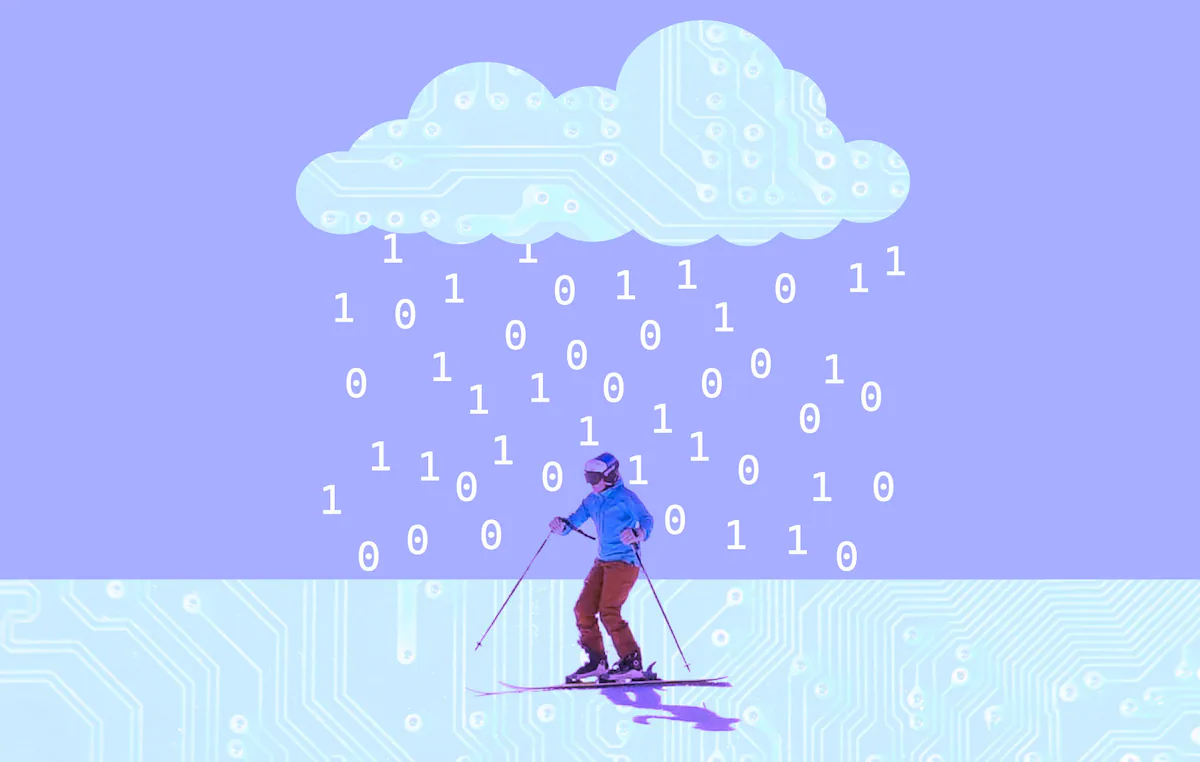Copyright Salt Lake Tribune

Few things have truly disrupted the ski industry in the last 100 years. Think the rise of snowboarding, the invention of shaped skis or the introduction of the multi-resort season pass. Yet another metamorphosis is literally hanging in the air. It’s the arrival of artificial intelligence-informed snow forecasting. And if the scientists — the very people the technology threatens to replace — are correct, starting this season a day on the slopes will never be the same. Especially here. “There is,” local forecaster Evan Thayer said, “no place that will benefit more from AI weather forecasting than Utah.” Imagine a family of skiers scheduling a vacation and picking the resort they’ll visit based on which one will get the most snow during the three days they’re in town. Then, imagine them being able to pull up to a ski resort just as the flakes start falling. Throughout the day, they might receive alerts about where snow is piling up on different areas of the mountain, or when to duck into the trees to avoid the wind. An app on their phone might even tell them that powder can be found in the east bowl in the morning, but that it will be as slippery as a bobsled track after lunch. Then, after an optimal day on the slopes, they’ll time their departure for exactly 4:18 p.m., the start of the only 35-minute break in the storm. “It’s pretty exciting,” said Jim Steenburgh, a professor of atmospheric science at the University of Utah. “I think it’s going to be a time of revolutionary change in weather forecasting.” And, Steenburgh and Thayer agree, on-mountain improvements are just the tip of AI forecasting’s potential. What is AI forecasting? Thayer’s weather predictions have become an integral tool in most skiers’ quiver, whether they’re 100-day diehards or casual visitors. He’s refined his knowledge of Utah’s weather patterns over the course of 16 years of forecasting, 12 of which he’s spent as the Utah forecaster for OpenSnow.com. “I can’t get enough of it,” he said. “So, I am always looking at data. I’m always looking at everything. I’m going back and comparing what happened to what was forecast.” Part of what makes Thayer so trusted by skiers and resorts alike is that he brings his own historical biases and knowledge of quirky resort microclimates to his reports. That’s especially valuable in Little Cottonwood Canyon, where where the sharp elevation gain and Utah’s famous lake-effect conditions often come into play. Together, they’re key contributors to the canyon’s overabundance of snow — often several inches over what was expected — that regulars to Alta Ski Area have come to know as “Alta Magic.” Thayer, who lives in the Town of Alta, knows all about Alta Magic. And yet, even after adjusting for it, he still often forecasts far less snow than actually falls on the resort. Over the course of any given season, he said, he underestimates the snowfall in Little Cottonwood Canyon by 30% to 40%. The new AI modeling system he’s been tinkering with — which OpenSnow tested in Utah because of its geographic idiosyncrasies — tends to land much closer to the mark. How much closer? In Thayer’s initial test against it in February, it more accurately predicted the snowfall than he did at seven out of 10 Utah resorts. In another trial, it was fed data from the 1982-83 season, one of the snowiest on record. It came within 1% of predicting the actual snowfall total. “Without a doubt it’s the future,” Thayer said. Why are the new models so much more accurate? Is it AI Magic? Not really. The AI systems access the same historical data and weather patterns that Thayer and Steenburgh use to make their forecasts. The difference is that traditional systems used by forecasters analyze weather patterns between grid points that are about 10 square miles (16 square kilometers) apart. So, they may offer the same forecast for the Salt Lake Valley as for Snowbird, even though those locations rarely see the same weather. More accurate systems exist. However, they take considerably more computing power. Thayer said one algorithm that can calculate the weather within 3 square kilometers takes so long to process that it can only be run about every 18 hours. AI modeling, meanwhile, can take in much more of that historical information and process it much faster than humans and their traditional modeling systems with fewer errors and data omissions. Plus, since it’s machine-learning AI, it can build up knowledge of the quirks of a specific ski area over time — just as Thayer and Steenburgh have. “I’m a human. I can only take in so much information, and I only have so much I can remember,” Thayer said. “This takes in millions of times more than I could ever process, does it instantly and looks at it. “So, basically, it’s taking my job.” How will AI forecasting change skiing? Thayer isn’t joking. He knows he can’t compete when it comes to analyzing data, and he’s likely to fall farther and farther behind. He is better than AI at one thing, though: being human. He said he thinks people connect with the “human touch” of the reports he composes for OpenSnow. He prides himself on his conversational style and his ability to pull back the curtain on tricks of his trade — like his recent nugget about how to find the snow depths at a resort that isn’t reporting them. People also turn to his Daily Snows reports for information on how the snow is skiing. Is it powder on top with ice underneath? Is it slushy? “There will always be people,” Thayer said, “who prefer just some guy who is passionate telling them what’s going to happen.” Well, maybe not always. OpenSnow already has an AI model in the works that predicts ski conditions. By taking into account factors such as when it last snowed, how wet the snow was and how much sun an area gets, PeaksSnow can direct skiers and snowboarders to areas on the mountain where they’ll find the best conditions and maybe even a few powder stashes. Thayer said he expects OpenSnow to release that, as well as an avalanche prediction model, before the end of the 2025-26 ski season. Used in conjunction with training and common sense, as well as advice coming out of the Utah Avalanche Center and other avalanche forecasting organizations, PeaksAvy could make backcountry travel safer by predicting when slides are most likely to happen. Of course, improved weather forecasting has applications well beyond improving a day on the slopes. A company called StormNet, which was recently purchased by OpenSnow, developed an AI algorithm to predict lightning strikes and hurricane landing zones. Steenburgh suggested businesses could use the AI technology to stockpile weather-related products, such as umbrellas during a monsoon. OpenSnow has claimed all three are first-of-its-kind innovations. However, it is not the only weather entity using AI. Google employs AI in some of its forecasts, though not necessarily the ones on people’s phones. Europe’s version of the National Weather Service debuted a machine-learning model in February and the NWS established its own AI center in September. “It’s just a thing,” Steenburgh said, “where you really need to take weather forecasts more and more seriously.” Will better forecasting create ‘powder panic’? Most immediately in Utah, though, the change in the accuracy of weather forecasts is most likely to be felt by skiers and snowboarders. And they’re most likely to notice it in relation to mid-range forecasts, or those within the upcoming three to eight days. As those prognostications improve, out-of-state visitors and traditional ski bums alike will be better able to time their ski getaways to coincide with fresh snow. Thayer worried that might exacerbate what he called “powder panic” — when more people than usual try to get to the resorts to enjoy the bounty of a big snowstorm. However, Alison Palmintere, a spokesperson for Ski Utah, doesn’t think that’s likely. While Ski Utah and the National Ski Areas Association often cite snowfall as the main driver of a season’s ski visitation, Palmintere said most guests plan so early that day-by-day weather is less of a factor in their decision than the state’s reputation for being snowy. “We definitely see an uptick in visitation when we have great snow years. But is it a 100% determining factor of whether somebody comes to Utah? I would say no,” she said. “I think that many people come to Utah because they know that they’re going to have a great time regardless, and that it’s likely to snow regardless.” For all that will change with the incorporation of AI in meteorology, long-term forecasts are expected to retain some of their mystery. Weather is still part of nature, Steenburgh pointed out, and even AI can’t predict something that doesn’t follow a pattern. Of course, since that forecast is coming from a weatherperson, Steenburgh knows not everyone will trust it. “We’re just a bunch of weather guessers. But there’s a lot of science here, too,” he said. “And we’re definitely getting better, even if nobody believes it.”



